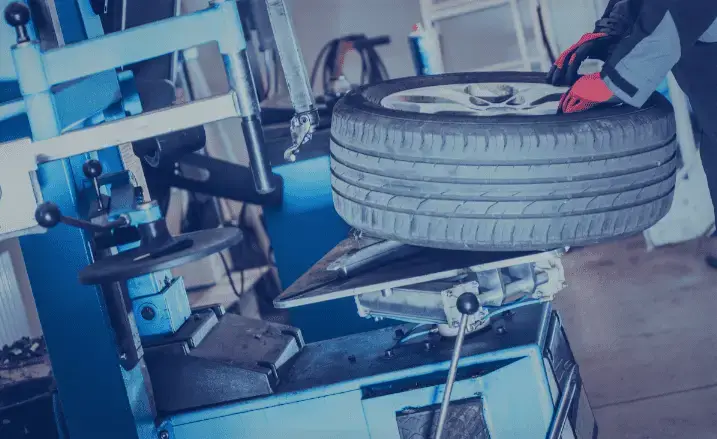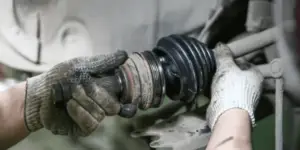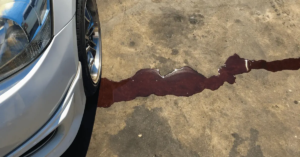It can be pretty annoying. You have got new tires fitted either in the hope it would stop your car steering shaking or it’s a problem that has only just appeared that wasn’t there with the old tires.
Depending on how bad the wobble is dictates whether it’s annoying or alarming.
Here we’ll explore the reasons and fixes and any associated costs.
In brief, your car is shaking after having new tires fitted because:
- Out of Round Tire
- Incorrect Tire Pressure
- Wheel Mounted Incorrectly
- Tire Balanced Wrong
- Wheel Alignment Needs Doing
- Wheel Bearing Bad
- CV Joint and Boot Corroded
Let’s get into the details now:
Bad Tire
It might be that your new tire is out of round. This is not normally something you would expect, but like anything new, there will always be some that sneaked past quality control, at the factory.
The tire shop fitter would have noticed anything too obvious but it doesn’t take too much of a defect to make the steering wheel wobble, especially at higher speeds.
Bad Tire Pressure
A real rookie tire shop error. It may be that the tire is overinflated – not underinflated. An underinflated tire may cause poorer handling but not a shake.
Overinflation will cause your tire to bounce a bit. Think of anything with too much air in it, it’ll bounce. A nice easy check is to drive it to the gas station and use the gauge.
Refer to the car owner’s manual and take any excess air out. Just depress the valve and let out a little at a time until you have the correct psi left in the tire.
Many visitors read this article next: Do Tires Lose Air When Parked? [ANSWERED]
Mounted Incorrectly
Perhaps the most dangerous mistake a car shop can make is not tightening the lug nuts enough. If the wheel isn’t seated properly, it will move around. This wobble is then transferred up to your steering wheel. It’s really rare for this to happen, though.
The lug nuts could be cross-threaded. This means that they have been tightened against the lug grain. Have you ever screwed a cap on a jar and not done it quite right? It looks okay at a glance but is not seated right. It’s the same principle here.
Hearing a slight roaring noise you didn’t have before your new tires?
Find out why in our recent article Why New Tires Making A Roaring Noise
Tire Balancing Needs Doing Again
Every time a new wheel is fitted it is balanced. This process involved the fitter either bubble balancing or spin balancing your new tire onto the wheel. A tire will never sit on a wheel perfectly.
There will always be a weight that needs be strategically placed to even out imperfections.
It’s possible that either
- The balance wasn’t done at all
- The balance was done but incorrectly
- A weight wasn’t removed from the wheel that was fitted on the inside the last time the old tire was balanced
- The weight has fallen off and the tire is unbalanced.

A bubble balance is an old-school way of balancing tires – this is less accurate but still sometimes used by smaller tire shops that can’t afford more modern equipment.
The more modern way is to use a spin machine. This way gives the fitter a digital image of where exactly the weight should be placed.
Both ways should be fine as long as the person fitting the tires knows what they are doing.
Bad Wheel Alignment
It’s unusual for bad alignment to cause shaking. There are more common symptoms of bad alignment.
You don’t need to get your wheels aligned every time you change your tires. Tire shops will always ask you if you want it done but unless your old tires have worn unevenly or your car has been pulling to one side you won’t need it done.
If you’ve recently driven over a pothole or hit a curb it may have altered your alignment a little. Is your steering wheel straight? This is a common sign the alignment is bad.
Wheel Bearings
If it’s been a few years since you’ve had the wheel removed from your car they can take a bit of force to remove it from the assembly. Often a rubber mallet is used to free this up.
Wheel bearings are tough components and are encased in a metal race. However, if they are starting to fail – even if it is not that noticeable a whack can speed this up.
A failing wheel bearing is normally accompanied by a grinding or screeching sound so if you’re not hearing this the wheel bearings are unlikely to be the cause of the shake.
CV Joint and Boot
A CV joint stands for a Constant Velocity Joint. It takes power from the transmission and provides it to the wheel. These joints sit at the end of the axle and are encased in a rubber boot.
As with wheel bearings, this part would be likely failing anyway but the movement needed to take the wheel off would exacerbate the problem.
Often the joint itself was good until the rubber boot split letting in moisture and dirt. This causes the CV joint seals to break letting out grease.

This is unlikely as the tire shop should have noticed grease from the joint on the inside of your wheel when they took it off.
As with wheel bearings, any play or movement in this part will be transferred to the steering wheel causing it to wobble.
Many visitors also read this article: Wheel Alignment Vs. Tire Balancing
Does a Car Feel Different After New Tires?
Your new tires may feel less responsive than your old tires. There is no need to be disappointed though.
If your old tires were quite worn they probably turned into corners better as there was less resistance than there should have been. A new tire has a 9mm depth of rubber on it and this amount of tread will grip better than your old tire.
More tread = less response when turning.
The good news is that you’ll notice a much better response when you brake. The extra rubber you’ve bought will slow you down quicker.
How Long Does It Take For New Tires To Break In?
In Summary
New tires are less flexible as they need to be worn in. 500 miles of driving is enough to loosen the metal and rubber of the tire and get it seated comfortably on the wheel. Think of your tires as shoes for your wheels.
To start with they may be a bit uncomfortable but eventually they free up and become more supple. Your tires leave the factory with agents and lubricants still on them.
They were applied when the rubber was in the tire mold to stop it from sticking.
During this bedding in process, your tires may vibrate or shake slightly.
Wheels that are unbalanced are probably to blame for vibration that develops after fitting new tires. The best course of action is to return immediately to the shop so they can investigate it. They are required by law to address the problem if their work is faulty.
If the shake is still present after more than 500 miles get them checked over by the tire shop that fitted them.
In the meantime, you always do the easier checks yourself such as checking tire pressure and checking out the condition of your CV rubber boots.



![Car Wobbles At Low Speeds - [Troubleshooter Guide] inflating-tire-on-balancing-machine](https://carzaza.com/wp-content/uploads/2023/12/inflating-tire-on-balancing-machine-300x150.png)









